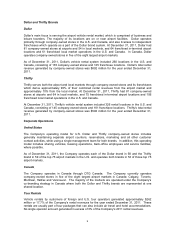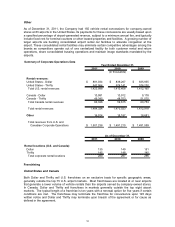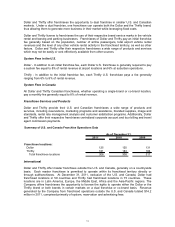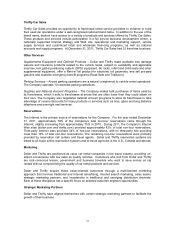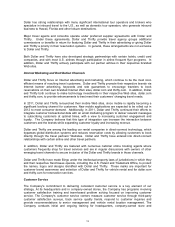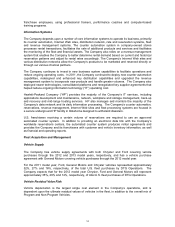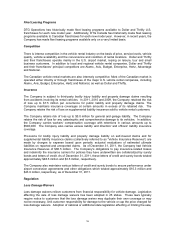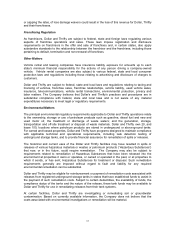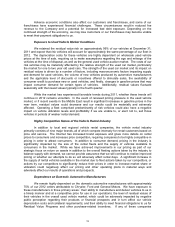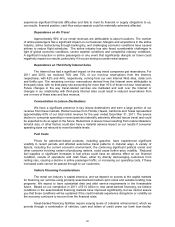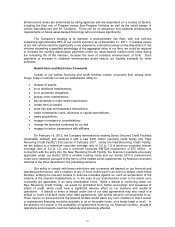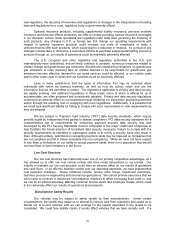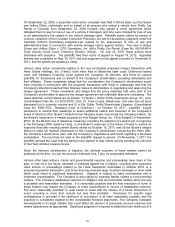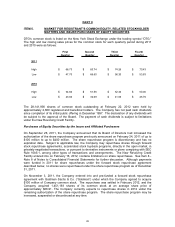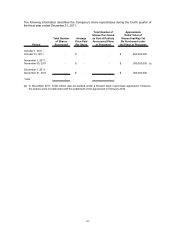Thrifty Car Rental 2011 Annual Report Download - page 21
Download and view the complete annual report
Please find page 21 of the 2011 Thrifty Car Rental annual report below. You can navigate through the pages in the report by either clicking on the pages listed below, or by using the keyword search tool below to find specific information within the annual report.Adverse economic conditions also affect our customers and franchisees, and some of our
franchisees have experienced financial challenges. These circumstances result in reduced fee
revenue to the Company and a potential for increased bad debt exposure. Depending on the
continued strength of the economy, we may lose customers or our franchisees may become unable
to meet their payment obligations to us.
Exposure to Used Vehicle Market Conditions
We retained the residual value risk on approximately 96% of our vehicles at December 31,
2011 and expect that risk vehicles will account for approximately the same percentage of our fleet in
2012. The depreciation costs for these vehicles are highly dependent on wholesale used vehicle
prices at the time of sale, requiring us to make assumptions regarding the age and mileage of the
vehicles at the time of disposal, as well as the general used vehicle auction market. The costs of our
risk vehicles may be materially affected by the relative strength of the used car market, particularly
the market for one to two year old used cars. The strength of the used car market and its impact on
residual values is driven by a number of factors, including macroeconomic factors impacting supply
and demand for used vehicles, the volume of new vehicles produced by automotive manufacturers
and the applicable level of discounts or incentives offered to stimulate sales, the availability of
consumer credit to purchase new or used vehicles, and finally, changes in gasoline prices that may
impact consumer demand for certain types of vehicles. Additionally, residual values fluctuate
seasonally with the lowest values typically in the fourth quarter.
While the market has experienced favorable trends during 2011, whether these trends will
continue in 2012 remains uncertain. In the event of renewed pricing pressure in the used vehicle
market, or if recent events in the Middle East result in significant increases in gasoline prices in the
near term, residual values could decrease and our results could be materially and adversely
affected. Operating a fleet comprised predominantly of risk vehicles could also have a negative
impact on vehicle utilization levels and profitability if we are unable to, or elect not to, sell those
vehicles in periods of weaker rental demand.
Highly Competitive Nature of the Vehicle Rental Industry
In addition to local and regional vehicle rental companies, the vehicle rental industry
primarily consists of nine major brands, all of which compete intensely for rental customers based on
price and service. The Internet has increased brand exposure and gives more details on rental
prices to consumers and increases price competition, requiring companies to be highly competitive in
pricing in order to attract consumers. In addition to consumer demand, pricing in the industry is
significantly impacted by the size of the rental fleets and the supply of vehicles available to
consumers in the market. While we have achieved improvements in our pricing as part of our
strategic focus on return on assets in addition to the overall fleeting actions taken by the industry to
balance supply with demand, we cannot provide assurance that we will continue to realize improved
pricing or whether our attempts to do so will adversely affect rental days. A significant increase in
the supply of rental vehicles available in the market due to fleet actions taken by our competitors, or
actions by our competitors to significantly reduce their prices in order to increase market share or
utilization could negatively affect our pricing and other operating plans in material ways and
adversely affect our results of operations and prospects.
Dependence on Domestic Automotive Manufacturers
We remain highly dependent on the domestic automotive manufacturers with approximately
75% of our 2012 orders attributable to Chrysler, Ford and General Motors. We have exposure to
these manufacturers in three primary areas: their ability to manufacture and deliver vehicles to us in
a timely manner and at a competitive price for use in our operations; the level of residual values of
their vehicles in the overall used vehicle market, which could be adversely impacted by negative
public perception regarding their products or financial prospects and in turn affect our vehicle
depreciation costs and collateral requirements; and their ability to meet financial obligations to us for
Residual Value Programs and other purchase-related incentives. If any of these companies
19


